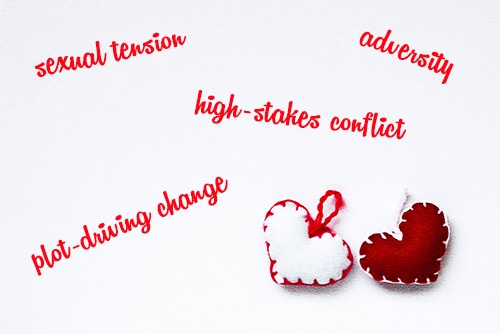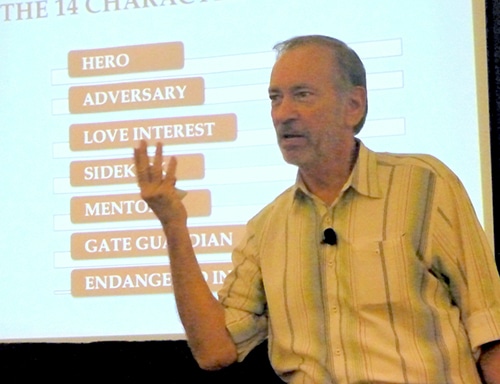Your Romantic Screenplay Starts Here
With Valentine’s Day approaching, even the most cynical minds might find their thoughts drifting to romance. Shops and restaurants bombard us with symbols of love, and Hollywood is gearing up to release this year’s romantic movie offerings. On February 14th the theaters will fill up with singles and couples, either escaping their singledom with dreams of future romance or hoping their significant others will pick up some new tips on romantic gestures.
Who doesn’t love a good romance story? Well, most of us do anyway! It comes back to the fact that no matter how technologically advanced we become as a planet, our needs for romantic love and intimate companionship don’t change. The elements of a good romance – sexual tension, adversity, plot-driving change, high-stakes conflict – are all here to stay.
Another reason for the popularity of the romance genre is that it lends itself to mixing with other genres. In the early days of film, many romance movies had a strong dramatic element in them. But since then other sub-genres like Chick Flick, Romantic Thriller, Romantic Comedy, and even Romantic Action Comedy have emerged to add more humor. If you’re not sure which one is best for you as a writer, read on for a breakdown of the different romantic sub-genres.
There are five of them, each with their own way of telling a romance story and featuring different types of conflict between the main character (hero or heroine) and the love interest character.
Romance Dramas: romantic dramas are serious in tone, center around the hero and their love interest caught in a serious real-world problem. The main conflict is to overcome whatever troubling obstacles prevent the couple from coming together. They’re the classic love stories, often immortalized on the big screen, like Titanic, The English Patient and An Officer and a Gentleman that resonate with us long after we leave the cinema. Romantic dramas often receive critical acclaim, along with the actors who play the lead characters. Perhaps the reason is that the drama genre gives more space to an in-depth exploration of the source of the adversity, be that social class, cultural or age differences, circumstances such as war or other physical disaster, or the protagonist’s own psychological barriers to the relationship. Lead characters in a romantic drama generally have more depth, and the unfolding of these characters acts as an extra source of audience involvement.
In this and all other sub-genres, the love interest character doubles also as the adversary while the lovers struggle to resolve the big problem keeping them apart. The conflict could be a result of outside influences, such as Memoirs of a Geisha or Pride and Prejudice (social hierarchies), or, like Casablanca or Titanic, where it’s the presence of another interfering character such as a competing spouse or fiancé. Alternately, the conflict can be the result of internal or personal influences, such as A Walk to Remember and Love and Other Drugs (inner struggle and sickness). In romantic dramas, the clash of hero and love interest characters always creates a serious central dramatic conflict, although humor can sometimes be used as well.
Chick Flicks (often called): this sub-genre generally targets a female audience by emphasizing emotion and relationships over action, or by featuring a woman or a group of women as the central characters. While a “Chick Flick” is not necessarily a pure romance movie, the central relationship is often between the hero and a love interest character (as in The Notebook, in which the main conflict is one woman resolving her feelings for two different men and choosing between them). It can often, however, revolve around the relationships of multiple characters with each other – the love interest relationship being one within a wider circle of dynamics. An example of this is The Holiday, a film about the relationships between four people involved in two simultaneous love stories, but also about the connections between all four people. The “Chick Flick” can also focus primarily on the profound changes in a woman’s life as a new love interest comes into the picture, as in Grease, Clueless, or Pretty Woman. Generally, a Chick Flick is a movie with a main theme of relationships, including a romantic relationship, that centers around a woman lead.
Chick Flicks are probably best described as films having a central character that women can very much relate to, and that focus on the ups and downs of being a modern woman. Bridesmaids written by Kristen Wiig & Annie Mumolo is a great example. DOWNLOAD ERIC EDSON’S HERO GOAL SEQUENCES FOR BRIDESMAIDS HERE. Although the film is about an upcoming wedding, the theme of the movie is really female friendships and where would women be without them. Thelma and Louise is often said to be the grand dame of Chick Flicks, and here the theme is freedom, usually from the impositions men place on women which stop them from gaining that freedom, as opposed to 500 Days of Summer which is a romantic comedy but not a Chick Flick, since the story is told from the male perspective.
Romantic Comedies: light-hearted fare that features humor within a love-themed story. The main conflict could revolve around the hero and a love interest character, like The Proposal, in which the polar-opposite personalities of the two potential lovers make for laughable encounters, or as in How to Lose a Guy in 10 Days, where the conflict between a woman and her love interest plays out in other humorous ways.
Common themes are the idealization of love and one’s partner, love at first sight, and the idea that love conquers all. These films share some characteristics with romantic drama in that the two people seem to be well matched, but they are kept apart by some obstacle. However, as the plot and characters develop, they learn to overcome such obstacles and the ending is a happy one. The 1998 film, The Wedding Singer has all the elements of a classic romantic comedy, it’s about two likable main characters, both of whom are engaged to other people in less than ideal circumstances, but they seem to be a good match for each other. The female character in particular has to do a lot of soul searching before she defies societal conventions and calls off her wedding to her wealthy and successful fiancé in order to opt for the poorer but genuine hero, and they eventually become husband and wife. Romantic Comedy is similar to Romantic Drama in that the story hinges on adversity, but in Romantic Comedy, the obstacles are always overcome, leading to a permanent mate bond and happy-ever-after. In Romantic Drama, this is often not the case.
Romantic comedies can also be more like Chick Flicks, highlighting a romantic relationship within a larger scheme of characters and relationships. Examples are The Family Stone or Crazy Stupid Love, which combine the romantic conflict with family/friend relationships that complicate the conflict resolution in humorous ways.
Romantic Action Comedies: these combine a romantic storyline with both humor and action. As opposed to a romantic comedy in which the humor is most often verbal, the humor in a romantic action comedy can be physical or slapstick as well. This genre of romance film has only been around for a comparatively short time, beginning (more or less) with the 1984 classic, Romancing the Stone. More than any other genre, romantic action comedy has seen its female protagonists undergo a transformation. No longer content to be the damsels in distress, a female protagonist in this genre is as likely to be wielding a gun as the male protagonist, and somewhere during an adrenalin rush, the fires of romance burst forth. One of the better known romantic action comedies is Mr. and Mrs. Smith, in which the central characters resolve their marital conflict through a series of action scenes as they try to kill each other. Other examples include A Knight’s Tale and The Princess Bride, where the hero characters fight to win the love interest character through various physical battles and funny interactions with other characters, especially those presented as adversaries. Romantic Action Comedies center around barriers that must be physically overcome to resolve the conflict.
Romantic Thrillers: have plotlines where the romantic conflict manifests in ways that are physically dangerous for the hero and/or the love interest character, adding in elements of rising suspense from the thriller genre. Examples include The Phantom of the Opera, where the main character and her love interest’s safety is threatened when they fall in love because of the disapproval of the menacing Phantom, or Hitchcock’s Vertigo, a psychological thriller/romance. Romantic Thrillers can involve danger from an outside force fought by a united couple, or a threat of physical danger created by conflict between the hero and love interest that keeps them apart. Other examples are Wicker Park and Match Point, romance thrillers where the threat comes from the love interest character themselves, who may or may not be the adversary, but somehow threatens the hero.
New York Times Best-Selling Author Rebecca York says romantic thrillers are books or films where, “the plot focuses on two people meeting, falling in love and working out their conflicts against a backdrop of danger and suspense. External forces threaten to destroy these people, but by the end of the book they triumph over the danger and make a commitment to each other.”
Where sexual tension is always the driving force behind a romance, in a romantic thriller the tension is heightened by the added element of life-or-death danger. This can sometimes be achieved by using the ‘shapeshifter’ character, i.e. the one who starts off disguised as a love interest, but who is later revealed as someone whose real intention is to do harm to the central character, while the real love interest, at first a background character, finally steps forward and wins the lead character’s love in the end. The Bodyguard is a shining example of the Romantic Thriller genre, when the romance develops amid the tension of protecting the female love interest from a dangerous stalker. The fact that this was one the highest grossing films of 1992 is testimony to the potential of the romance thriller.
Writing in the romance genre gives screenplay writers a chance to delve into one of the most profound human emotions, love. The five sub-genres of romance movies highlight the rollercoaster of experiences associated with love: happiness, fear, humor, intrigue, action and danger. The introduction of a love interest character adds depth to a screenplay and gives us insight into human truth through an experience anyone can relate to. Creating an engaging conflict between a hero/heroine and a love interest adds tension and meaning to a screenplay, and draws the audience in emotionally. There’s nothing more human than love – or more Hollywood than romance.
About The Story Solution: The Story Solution, by screenwriter and tenured university professor Eric Edson, is an in-depth handbook for authors who are writing a movie script. It reveals the 23 actions screenplay writers use to create dynamic, three dimensional heroes. Visit the website at https://www.thestorysolution.com to download a sample chapter of the book. “Like” the Facebook page to receive screenwriting tips and insider insights on writing screenplays.








